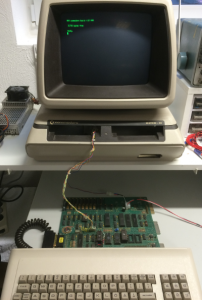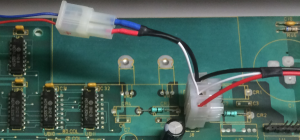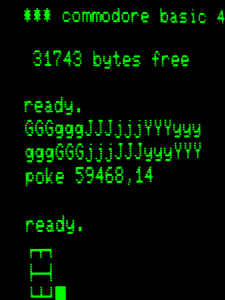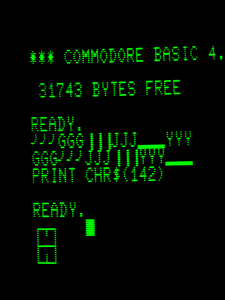Engineer’s Log, Labdate 0702.01. We have entered a spectacular binary star system in the Retrochallenge sector on a most critical mission of electronic research. Our mission is one of rescue and, if necessary, confrontation with a hostile force.
Scotty’s rule # 1:
1:
Never trust an ancient power supply.
Although the switching power supply seems to work ok, I wanted to add some reliability by using a benchtop power supply.
Removing the mainboard was easy but making an appropiate power adapter took me a while.
 My junk box offered no fitting connector, so I used three insulating screw joints (+12V, +5V, GND). Granted, it looks weird, but there is hardly any voltage drop across this connection.
My junk box offered no fitting connector, so I used three insulating screw joints (+12V, +5V, GND). Granted, it looks weird, but there is hardly any voltage drop across this connection.
However, there is a voltage drop of about 500 mV on the white wire. The small diameter of the original wires to the CRT (the blue and the red wire on the left) made me think there is only a small current flow, so I used the same diameter for the +12V line to the power supply. Shame on me. Every child knows
Scotty’s rule #2: Never underestimate the wattage of a CRT.
Anyway, the computer is up and running and we can start to investigate details of the CBM video system.
The model 8296 can display 25 rows of 80 characters in two modes, a text mode and a graphic mode. Don’t get confused by the term “graphic mode”. In CBM language it refers to several special characters that can be used to draw very limited line or block graphics (see example at the bottom of the following two pictures) and does not mean that you can plot arbitrary waveforms in pixel resolution (aka HiRes graphics). The latter is what this project is about.
Ok, let’s calculate the screen resolution in pixels. A single character is composed of 8 x 8 pixels, so the horizontal resolution is 80*8=640 pixels. The vertical pixel resolution depends on the current mode:
In text mode there are additional vertical gaps of two pixels between the rows to improve readability.
pixels between the rows to improve readability.
These gaps disappear in graphic mode. Therefore we get a vertical resolution of 25*(8+2)=250 pixels in text mode and a resolution of 25*8=200 pixels in graphic mode. Screen resolution is then 640*250=160,000 pixels at most (non interlaced) and it would take 160,000/8=20,000 bytes to buffer one HiRes page. Double that for interlaced mode.
Therefore we get a vertical resolution of 25*(8+2)=250 pixels in text mode and a resolution of 25*8=200 pixels in graphic mode. Screen resolution is then 640*250=160,000 pixels at most (non interlaced) and it would take 160,000/8=20,000 bytes to buffer one HiRes page. Double that for interlaced mode.